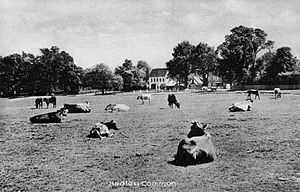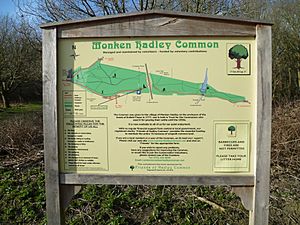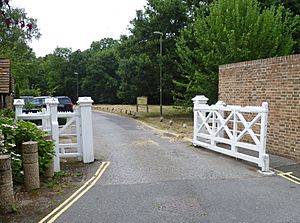Monken Hadley Common facts for kids
Monken Hadley Common is a special natural area in London. It's part of the Monken Hadley Conservation Area. This means it's protected because it's very important for nature. The London Borough of Barnet calls it a "Site of Borough Importance for Nature Conservation, Grade I." It is also "common land," which means it's owned by a group called the Trustees of Monken Hadley Common for everyone to use.
Contents
About Monken Hadley Common
This common is a large natural space. It covers about 72 hectares (that's like 178 football fields!). It stretches between the areas of Monken Hadley and Cockfosters. The common is about 1.5 miles long. It's shaped like a wedge, being half a mile wide at one end and getting narrower at the other.
How to Visit the Common
You can get into Monken Hadley Common from many different places. Some of these include Camlet Way, Parkgate Crescent, and Games Road. Two popular walking paths, the London Loop and the Pymmes Brook Trail, also go right through the common.
History of the Common
Monken Hadley Common is a small piece of a much larger old forest. This forest was once called the Royal Forest of Enfield Chase. In 1777, a special law was passed to divide up this big forest. Only a small part of it was given to the village of Monken Hadley. This small part is the only land from the old forest that stayed as a common.
For a long time, until the 1950s, local people used the common to let their animals graze. This means they would let cows or sheep eat grass there. The common is also split in half by the East Coast Main Line, which is a busy railway line.
Plants and Animals
The common is mostly covered by trees. You'll see many pedunculate oak trees, along with hornbeam, beech, and field maples. In some spots, holly bushes grow very thickly under the taller trees. Other areas have a mix of different bushes, like Midland hawthorn and hazel.
Some of the smaller plants on the ground are very old. They show that parts of the common have been a forest for a very long time. You might also spot different kinds of butterflies here, like the White-letter hairstreak and purple hairstreak. Many birds also live and breed here, including the Eurasian sparrowhawk and tawny owl.
Lakes and Ponds
Beech Hill Lake, also known as Jack's Lake, was created by building a dam across Pymmes Brook. People often go fishing here. Many common water birds also live on the lake. Daubenton's bats fly low over the water at night to catch insects.
There are also two smaller ponds on the common. These ponds have many different kinds of plants and lots of amphibians, like frogs and newts. These amphibians attract grass snakes, which like to hunt near the water.
Gallery








